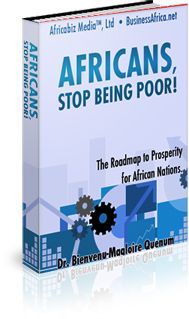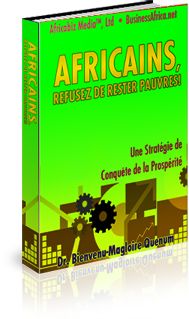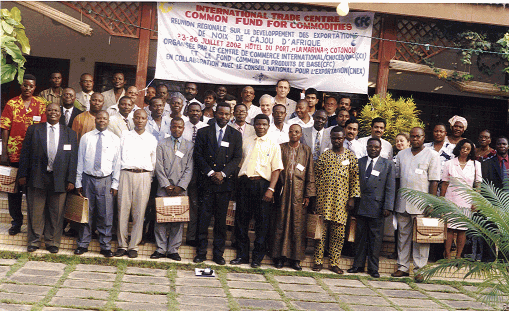|
****JavaScript based drop down DHTML menu generated by NavStudio. (OpenCube Inc. - http://www.opencube.com)****



|
| ! |
| AFRICABIZ
VOL 1 - ISSUES: 40 & 41
AUGUST
15 - OCTOBER 14, 2002
Previous
Issue
Editor: Dr. Bienvenu-Magloire
Quenum
Click here for contact & support console
| |
A
WORD FROM THE EDITOR
| | |
|
Dear visitor and international investor,
We
warmly welcome you, if this is
your first visit to Africabiz
Online - The ultimate newsletter
on trading and investing in 49
sub-Saharan African countries.
If you are a regular and faithful
reader, welcome back.
If you are a regular and faithful reader, welcome
back.
- THIS
DELIVERY STANDS FOR TWO ISSUES
AFRICABIZ Online's
team is taking one month break from September 1 to September 30. This delivery
therefore covers two months: August 15 to September 14; and September 15 to October
14. The next issue N° 42 will be online on October 15, 2002.
-
REGIONAL MEETING
ON EXPORT DEVELOPMENT OF CASHEW NUT FROM AFRICA /
JULY 23 -
26, 2002 / COTONOU - BENIN
African producers of Cashew nut - raw and processed nut - used to be major
players in dried fruits' business in the 1970's. (Benin, Burkina Faso, Cote
d'Ivoire, Guinea Bissau, Senegal, Kenya, Madagascar, Mozambique, Nigeria, Tanzania
- Click here for countries
briefs).
Their market share was around 78 % of world production
in the 1970's. Nowadays their part dwindled to 30%. More than 50 % loss within
30 years. During the same period other well organized big players, such as
India, catched up and took the lead. Furthermore, African producers participate
only to 20 % of cashew nut's international trade. Something in the range
of US$ 880 million out of a global transaction level of US$ 4.4 billion.
In order first to stop production's decline in Africa and second to increase African
producers' international market share, the International Trade Center (ITC)
/ UNCTAD / World Trade Organization (WTO) / Common Fund For Commodities (CFC),
in collaboration with Benin's
National Export Council ( Conseil National Pour l'Exportation - CNEX), organized
at Cotonou, Benin, a Regional Meeting On Export Development Of Cashew Nut From
Africa, July 23 -26, 2002.
 |
| Participants to Cotonou's Cashew Nut Meeting |
60 delegates from African producing countries and cashew nut experts from India
and Brazil attended the meeting.
After a welcome address by CNEX's
president, an opening speech by the representative of Benin's Ministry of Industry,
an introduction speech by ITC's Director of the Division of Product and
Market Development and a keynote address by CFC's representative, Mrs.
M. Maftei - ITC's Senior Commodity Officer - took the floor to speak about:
"The international cashew nut market and the share of African exporters:
evolution and prospects". Afterwards, experts in Production, Quality
and Standards, Marketing, Business Development and Management delivered several
supporting papers.
The causes deemed responsible for the collapse of
production were exposed by international specialists and national experts of each
producing country.
Four committees were then set up (Production,
Quality, Processing and Marketing) to analyze constraints, obstacles and hindrances
hampering the development of cashew nut in African producing countries. Suggestions
and recommendations made by the committees will serve as background for follow
up actions to improve productivity, processing and marketing.
Documents
and papers related to the Conference are available here
at the International Trade Center's website. Click on the Events tag
once on the website or make search with: Cashew nut, Cotonou, July 22-26,
2002.
Dr. Quenum attended the meeting and delivered a paper titled: "Cashew
nut processing and marketing. The importance of adequate profit oriented strategies,
investment decisions and business planning". That paper is written in
line with a previous delivery posted online here
about the collapse of Mozambique Cashew Nut Industry As Per May 2001. Dr. Quenum's
paper is available on the International Trade Center's website.
 -
Cashew Nut's international market value is currently US$ 4.4 billion. African
producers have 20% of said market against a production level of 30%. -
Cashew Nut's international market value is currently US$ 4.4 billion. African
producers have 20% of said market against a production level of 30%.
The 10 % gap between African producer's market share and their level of participation
into the international trade of cashew nut represents a formidable trade opportunity.
However a lot needs to be done, by the African producers, in terms of
productivity, quality and marketing efforts in order to gaining additional points
on the global marketplace of dried fruits.
Hence the importance and usefulness
of the initiative planned by the International Trade Center to setup a website
dedicated to Business to Business e-commerce trading and promotion of cashew nut
from Africa. For more click
here about a development titled: The usefulness of Business to Business
e-commerce for African commodities.
Contributor's Guidelines
is here to review. Your contribution
on "How African countries / entrepreneurs could bridge the developing
gap" is welcome.
Many thanks for dropping by and see you here on October 15, 2002.
Dr. B.M. Quenum
Editor
of AFRICABIZ

| | | |
BUSINESS
OPPORTUNITIES IN AFRICA
| |
- Several
business opportunities with high profit making potential which are economic
catalysts and components to the Strategy for African Countries - here
available - have been introduced to you. They are listed in following table.
| a-
SHEA BUTTER (Issues 5, 6,
7, 11,
12, 13)
b- BLUE GOLD (Issues 14,
15, 16,
17, 18,
19)
c- FREEZE-DRIED
PAPAIN (Issues 20, 21,
22 and here)
d- KENAF (Issues 23,
24)
e- VEGETABLE OIL
(Issues 25, 26,
27 and 28)
f- CEREALS (Issues 30,
31, 32,
33)
g- FRUITS (34,
35, 36,
37, 38,
39) |
-
TROPICAL FRUITS INDUSTRY AS INCOME BUILDING POWER FOR AN
AFRICAN COMMUNITY / PART VII : SOME ECONOMIC FIGURES ABOUT THE SETUP OF A PROCESSING UNIT TO PRODUCING TOMATO
PASTE
In Issue 38 the existing
potential market for fresh tomato in sub-Saharan African countries was estimated
at 585,000 metric tons per year. And in Issue 39
the global revenues generated by tomato plantations were summarized in following
table:
| GROSS
REVENUES X 1,000 US$ | | Hectares | 50 | 100 | 200 | 300 | 400 | 500 |
|
Metric tons | 2,500 | 5,000 | 10,000 | 15,000 | 20,000 | 25,000 |
|
Revenues | 21.9 | 43.8 | 87.6 | 131.4 | 175.2 | 219 |
According
to tomato industry'
statistics - for well managed tomato plantations, established from high yield
varieties of tomato seeds, and optimal tomato paste processing conditions - the
quantity of fresh tomato to producing 1 kg of double concentrated tomato paste
at 28° I.R. is around 5,89 kg.
If plantations are not well managed
(insufficient manure, excessive sunshine, imperfect or non existent irrigation,
etc.;) and if processing conditions are not optimized, the amount of fresh tomato
needed to producing 1 kg of double concentrated tomato paste at 28° I.R. could
jump to 8 - 9,2 kg.
-
DOUBLE CONCENTRATED TOMATO PASTE PRODUCTION IN RELATION WITH FRESH TOMATO QUANTITIES
Let's consider medium range conditions of production and take the quantity of
fresh tomato necessary to producing 1 kg of double concentrated tomato paste at
28° I.R. equals to 7 kg We obtain following table:
| CONCENTRATED
TOMATO PASTA / Metric Tons |
| Hectares | 50 | 100 | 200 | 300 | 400 | 500 |
|
Fresh tomato | 2,500 | 5,000 | 10,000 | 15,000 | 20,000 | 25,000 |
|
Tomato paste | 357 | 714 | 1,429 | 2,143 | 2,857 | 3,571 |
-
GROSS REVENUE / PROFIT ESTIMATION FOR A MEDIUM SIZE PROCESSING
PLANT
In Issue
N° 39 was given investment estimate to establishing 1 (one) hectare of
fresh tomato plantation; and yield per hectare estimated at 50 metric tons. The
resulting cost of production of one metric ton of fresh tomato being approximately:
US$ 43.82, which compares well with figures in following Table
. The selling price of fresh tomato was put at: US$ 52.58 per metric
ton (20 % profit margin above cost of production).
Table below -
adapted from Tomatoland
/ June 2002's figures - gives the selling prices (in red / US$) of
various processed tomato products.
| SELLING
PRICES OF TOMATO PROCESSED PRODUCTS |
| Peeled
1 kg
| Peeled
500g
| Diced
Peeled
500g
| Paste
70g
| Paste
500 g
| Paste
1 Kg
| Passata
500g | Spain
| 4.150
| 4.250
| -
| -
| -
| -
| -
| Italy
|
4.250
| 4.380
| 4.480
|
6.800
|
7.500
|
7.600
|
2.080 | France |
- | -
| 5.300
| 7.300 | -
| -
| -
|
- Let's consider investment related to establishing a medium
size processing plant for the transformation of 15,000 metric tons of fresh tomato
into 2,143 metric tons of double concentrated tomato paste at 28° I.R. One
shift; 6 days / week (312 days / year); 48.077 metric tons of fresh tomato per
operating day.
| | Amount
(US$ x 1,000) | |
INVESTMENT
| | 1-
Land and buildings: Land acquisition - Plant (800 sq.
meter) - Offices (150 sq. meter) - Housing for management (3 x 100 sq. meter)
| 350
| |
2- Processing Equipment: Know How acquisition - Equipment
purchase and setup - Blank Startup Assistance (for three months) - Spare Parts
- Storage tanks - Cold room and so on. |
1,475
| | 3-
Other Equipment: Offices equipment - Four 10 metric
tons trucks - Three four wheelers - Housing furniture and so on
| 450 |
| 4-
Starting expenses: Feasibility study / Business Plan
for the processing plant - startup technical assistance (for six months) and so
on. Click
here for tentative terms of references covering
the processing plant establishment (Plantation establishment's Feasibility Study
/ Business Plan excluded. Click
here For plantation's figures).
| 185
| |
Total
investment | 2,460 |
| PRODUCTION
LEVEL |
| Tomato
Concentrate at 28° = 2,143 metric tons
| | OPERATING
COSTS | |
Operational
Expenses: Raw material
purchasing (fresh tomato, salt and so on) - production costs - insurance - utilities
- staff and hands / management salaries - external management assistance - amortization
- interests on loan and so on.
| 1,419 |
| PRODUCTION
COST PER METRIC TON | | 2,143
metric tons of Double Tomato Concentrate Paste at 28° I.R. = | 662 |
| GENERATED
REVENUES* | |
2,143 metric tons of paste x 1,500 US $ per metric ton | 3,620 |
| GROSS
PROFIT | 2,201 |

|
- Interested parties - private African and international investors /
companies, government
agencies,
international development
agencies - to make contact through the Free Access Support Console available at this link
Contact through the support console will get quickest reply from Africabiz Online's staff, than contact by emails. Click here for contact information. Be advised that first contact should be through the support console to be followed by phone calls. If you are a VIP-Member, use VIP-Members Support Console available here.
Before you consult please click
here to review this clarification
| |

